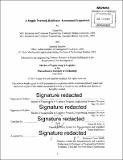A supply network resiliency assessment framework
Author(s)
Siu, Jaspar (Jaspar W.); Stephen, Santosh
DownloadFull printable version (11.25Mb)
Other Contributors
Massachusetts Institute of Technology. Engineering Systems Division.
Advisor
James B. Rice, Jr.
Terms of use
Metadata
Show full item recordAbstract
Supply chain resiliency is a relatively new field within supply chain management. Many quantitative and qualitative resiliency frameworks are available. However, there is a need for a hybrid framework that provides a more comprehensive resiliency assessment. In this thesis, we attempt to synthesize important features from different assessment frameworks and develop a hybrid resiliency assessment framework that more comprehensively addresses resiliency assessment. Our proposed framework combines quantitative assessment with a qualitative assessment to create a single Balanced Scorecard of Resiliency (BSR). We deployed the quantitative assessment of the BSR framework in a single commodity supply chain of ABC Company, and were able to compute the expected business impact risk of each node. We also aggregated across multiple nodes to assess the expected business impacts of each of the facilities, suppliers and locations of ABC Company's supply chain, and identify the critical entities in the supply chain for mitigation planning. For the critical facilities, suppliers, and locations, we developed response curves of the expected business impact for key parameters to identify the best mitigation options and the extent of investments. Lastly, we used a supply chain visualization tool called Sourcemap to visualize the expected business impact risk in both a map view and supply network view. Our quantitative assessment of resiliency allowed us to gain insights and generate recommendations for improving ABC Company's supply chain resiliency.
Description
Thesis: M. Eng. in Logistics, Massachusetts Institute of Technology, Engineering Systems Division, 2015. Cataloged from PDF version of thesis. Includes bibliographical references (pages 90-91).
Date issued
2015Department
Massachusetts Institute of Technology. Engineering Systems DivisionPublisher
Massachusetts Institute of Technology
Keywords
Engineering Systems Division.